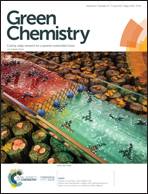Catalytic production of renewable lubricant base oils from bio-based 2-alkylfurans and enals†
Abstract
Lubricants are an essential part of modern society with an over $146 billion market but have significant environmental footprint. Bio-based lubricant base oils can offer performance advantages over existing oils and mitigate environmental challenges. We describe, for the first time, the synthesis of new bio-based base oils with tunable molecular branches and properties in high yields (>80%) from biomass derived 2-alkylfurans with enals via conjugate addition-hydroxylalkylation/alkylation (CA-HAA) and hydrodeoxygenation reactions. Among several liquid and solid sulfonic acid catalysts tested for the CA-HAA condensation, Aquivion PW79S, a perfluorinated sulfonic acid resin, exhibits the best performance. Subsequent hydrodeoxygenation of the condensation products with an Ir-ReOx/SiO2 catalyst gives up to an 88% yield of lubricant ranged branched alkanes with high selectivity and superior properties compared with commercial mineral group III and synthetic poly-α-olefin (PAO) base oils. Importantly, the molecular size and number of branches of the products can be tuned by varying the molecular size of substrates in the CA-HAA step. The as-synthesized base oils possess tunable properties and are promising for a wide range of applications.



 Please wait while we load your content...
Please wait while we load your content...